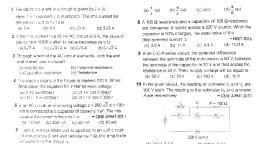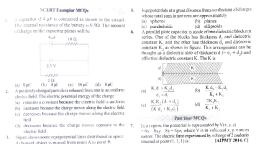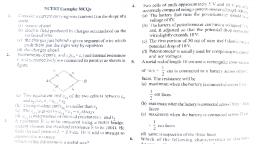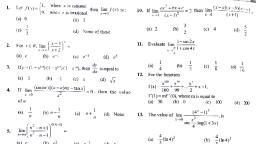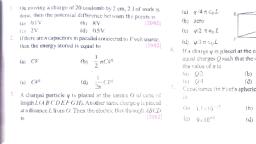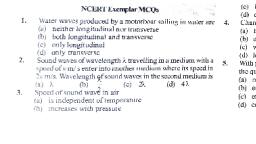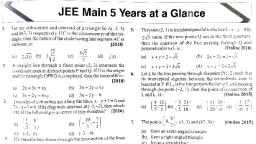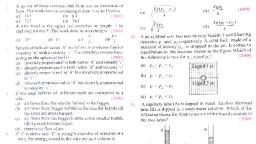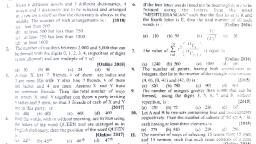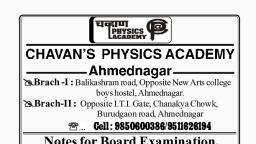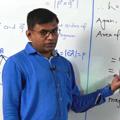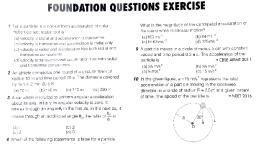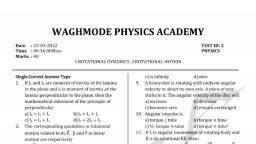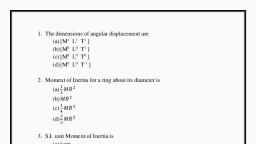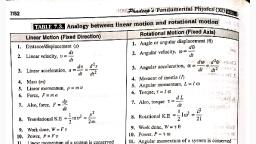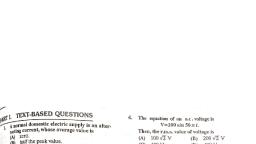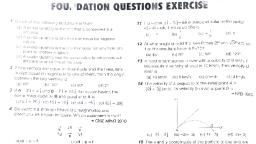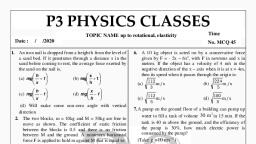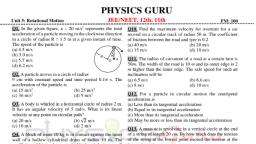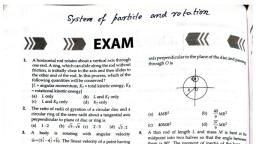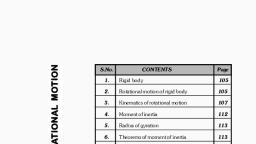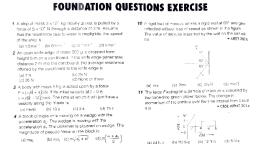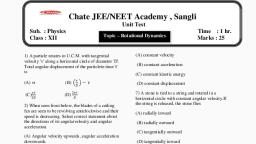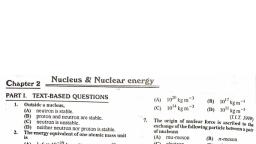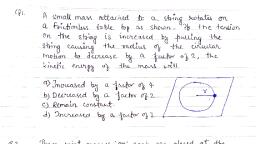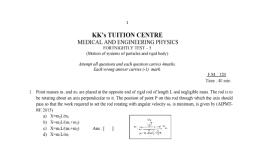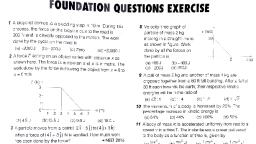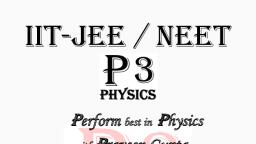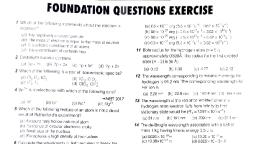Page 1 :
Initial angular velocity ofa circular disc of mass Mis o., Then two small spheres of mass m are attached gently to, diametrically opposite points on the edgeofthe disc. What, is the final angular velocity of the disc?, 2002], , (a), , M +m, M, , M, , (c), , M +4m/, , M +m o, , (b), , 0.6 to avoid skidding is, , 2002, , (c) 15, (a) 60, (b) 30, (d) 25, A cylinderof height 20 m is completely filled with water. The, ofeftlux of water (in ms ) through a small hole on, the side wall of the cylinder near its bottom is, 2002, (a) 10, (b) 20, (d) 5, (c) 25.5, , velocity, , m, , M, (d) M+2m, , The minimum veiocity (in ms') with which a car driver must, , traverse a flat curve of radius 150 m and coefticient offriction, , 1., , Iwo identical particles move towards each other with, , velocity, mass is, , (a), , V, , 2v and, , v, , respectively., , (b) v/3, , The velocity of centre, , (c) v2, , of, , 2002), (d) zero.
Page 2 :
solid sphere, ahollow sphere and a ring are released from, top of an inclined plane (frictionless) so that they slide down, , (a), , A, , the plane. Then maximum acceleration down the plane is for, , (c), , 2002], , (d), , (no rolling, , (a), , (b), , solid sphere, , Mand radius r about a line perpendicular to the plane of the, , (d) all same., Moment of inertia ofa circular wire of mass M and radius R, 2002], about its diameter is, MR2, (c), 2MR2, MR/2, (d) MR24, (b), (a), (c), , 7, , ring, , m moves along line PC with velocity v as, A particle of mass, shown. What is the angular momentum of the particle, , (a), , 8., , (a), , mvl, , (c), , mvr, , (d), , zero., , is applied at the point Pparallel to, , (a), , Iy = 32Iy, , (c), , Iy =Ix, , (b), , [2003, , (a), , 17., , system about, , (d), , 4L, , particle having position, be the torque ofthis force about the origin., , vector, and T, , Then, (a) F.T=0, , and, , acting, , (a), , on a, , 18., , 2003, , F.T, , (b)F.T, , 0, , (d), , 7.T0 and F.T +0, , F.T, , =, , 0 and, , F.T, , increased, , keeping, , mass, , same, , (c), , Moment of inertia, , (d), , 0 and, , F,T, , =, , Fi-), , 0, , (b), , -Fi + i), , which, , one, , Rotational kinetic energy, , and, , their, , diameters, , (a), , same outer, are, , R is rotating about, A thin circular ring of mass m and radius, Two objects each, »., its axis with a constant angular velocity, ends of a, the, to, opposite, of mass M are attached gently, an angular, with, rotates, now, The, ring, diameter of the ring., , 2006], , 2004], , ( m +2M), , (a), , (d) T d, , where d, , and d, , A, , of mass M, , body A, Lunder, , (c), 20., , are their densities., , gravity breaks, , downwards, while falling vertically, , into twaparts;, , a, , body B, , of, , mass, , 3, of, , M. The centre of mass, body C of mass, of, shifts compared to thi, les B and C taken together, [2005], body 4 towards, and, , a, , 21., , (b), , o(m -2M), (m +2M), , (d), , (m +2M), , m, , om, , (c)I =IB, , Z, , velocity =, , (b) I4> lp, , <B, , 3m4, , (d)-Fi-j), , 19., , about, radii. Their moment of inertia, and lB Such that, , respectively 14, , (c), , parallel to BD, 2006], (d) m2, , A and, , ()Fi+, , of the, , One solid sphere A and another hollow sphere B are ofsame, , mass, , passing through, , coordinate, A force of -Fk acts on 0, the origin of the, is, 20061, the, about, (1,, -1), The, point, torque, system., , a), , 2004], ?, following will not be affected, (b), Angular momentum, (a) Angular velocity, , axis, , (b) 3ml2, , 2m, , =0, , A solid sphere is rotating in free space. If the radius of the, is, , an, , 1S, , 4, , Let F be the force, , m2 d, , m, , of a square ABCD of side . The moment of inertia of this, , 2003, , new angular momentum is, , (c), , 2006], , d, (d) d, (c) m2, (b) m +m2-d, corners, Four point masses, each of value m, are placed at the, , (d)y 64/y, , (b) 2 L, , (c), , (b), , the same position?, , Iy = 16/y, , A particle performing uniform circular motion has angular, then the, frequency is doubled & its kinetic energy halved,, , Spnere, , F, , (d), Consider a two particle system with particles having masses, towards the centre, is, m, and m,. If the first particle pushed, the, of mass through a distance d, by what distance should, at, second particle is moved, so as to keep the centre of mass, , (a), , Then the relation between the, , plate of thickness, , moment of inertia Iy and Iy is, , ., , 3, , 2005, , respect to C., , of, , (c), , Mr, , the translational motion without, rotation. Find the location ofPwith, , 16., , 10., , (d), , lying on a smooth floor. A force'F, , A circular disc X of radius R is made from an iron plate of, thickness 1, and another disc Y radius 4R is made from an, , (a), , c)Mr, , AB, such that the object has only, , (b), , iron, , M)M, , shaped object with, A, dimensions shown in the figure, is, , 15., , C, , mvL, , [2005, , disc through the centre is, , 2002, , about P?, , body B, body C, , The moment of inertia of a uniform semicircular disc of mass, , 14., , hollow sphere, , does not shift, , (b) depends on height of breaking, , (m +M), , from a bigger circular, A circular disc of radius R is removed, of the discs, circumferences, disc of radius 2R such that the, is, a/R form, disc, new, coincide. The centre of mass of the, is, value, of, The, o, 20071, the centre of the bigger disc., (d) 1/6, (c) 1/2, (b) 1/3, (a) 1/4, Mand moment of, A round uniforn body of radius R, mass, , inertia I rolls down (without slipping) an inclined plane, , making an angle 0 with, IS, , the horizontal. Then its acceleration, 207
Page 3 :
(a), , 22., , (b), , 1-MR/, , (d), , 1+ MR1I, , Angular, , I+!/MR, , (a) continuously decreases, (b) continuously increases, , g sin 0, , 8 Sn0, , (c), , a diameter of the disc to reach its other, end. During, journey of the insect, the angular speed of the disc. the, , gsin 6, , gsin 6, , momentum, , of the, , (c), , 1-1/MR, , particle rotating with, , a, , 120071, , force is constant due to, , (a), (b), , central, , (c), , constant torque, constant force, constant linear momentum, , (d), , zero torque, , (d), , 29, , reversed, is:, (a) more than 3 but less than 6, (b) more than 6 but less than 9, , 20071, , is ),, , 30, , AD =31EF, , (d) 4C= lEF, , 4, , A thin rod of length L' is lying along the x-axis with its ends, , at=0 andr=L. Its linear density (mass/length) varies with, , more than 9, less than 3, A hoop of radius r and mass m, rotating with an angular, velocity, is placed on a rough horizontal surface. The, initial velocity of the centre of the hoop is zero. What will, be the velocity of the centre of the hoop when it ceases to, slip ?, JEE main 2013, , (a), , , where n can be zero or any positive number. If, , xas k, , the position xcx of the centre of mass of the rod is plotted, against n', which ofthe following graphs best approximates, the dependence of X, , on n?, , 2008], , CM, , (b), , ***, , 2, , ..=, , magnitude., , magnitude., 32. Distance of the centre of mass of a solid uniform cone from, its vertex is zg. Ifthe radius of its base is R and its height is h, JEE Main 2015), then Zg is equalto:, , (d), , ri**, , -I1, , O, , Consider a uniform square plate of side 'a' and mass 'm., The moment of inertia of this plate about an axis, , perpendicular to its plane and passing through one of its, , 20081, , corners 1s, , 5, , 2, , (5), , ma, , (c)ma, 12, , 2, , 2, , (d)ma2, , A thin uniform rod of length I and mass m is swinging freely, a, axis passing through its end. Its maximum, angular speed is o. Its centre of mass rises to a maximum, , height of:, , 2009, , 1l, , 1/2, , 5h, , a), , 1o2, , 8, , (b), , 3h, , (c), , 8R, , h, , axis passing through its center and perpendicular to one ot, , JEE Main 2015], , its faces is, , 4MR2, , (a), , 93, , (b), , 4MR, 33T, , together two, , cones, , 2, , (a)&, , (b), , (C), , g, , (d), , 3, , (d), B, , l6v2T, D, , at their, , vertices 0. It is kept on two rails, , joining AB and Cd (see figure)., It is given a light push so that it, , (d) 3g, , 322T, , 34. A roller is made by joining, , and radius R. Assuming pulley to be a perfect uniform, circular disc, the acceleration of the mass m, if the string, does not slip on the pulley, is:, 20111, , (b), , MR, , MR, , (c), , AB and CD, which are placed, , 6 g, , 4, , possible volume is cut. Moment of inertia of cube about an, , (c), 2, 68, A mass m hangs with the, help of a string wrapped around, a pulley on a frictionless bearing. The pulley has mass m, , (a), , d), , 4R, , 33. From a solid sphere ofmass M and radius Ra cube ofmaximum, , 3, , about horizontal, , 23., , oflength, , (d) angular momentum changes both in direction and, *****, , O, , 26., , (c), , of mass, , n, , O, CM, , s******, , ***********************, , (a)ma, , (b), , (d) ro, 3, 31. Abob, m attached to an inextensible string, i s suspended from a vertical support. The bob rotates in a, horizontal circle with an angular speed orad/s about thevertical, About the point of suspension:, JEE Main 2014, (a) angular momentum is conserved., 4, , direction., (c) angular momentum changes in direction but not in, , 2, , n, , (c), , r@,, , (b) angular momentum changes in magnitude but not in, , ****, , (a), , 2011, , (c), (d), , 4c=V2 IEF, , (b)21C =lEF, (c), , remains unchanged, pulley of radius 2 m is rotated about its axis by a force, F= (201-51) newton (where t is measured in, seconds), , A, , applied tangentially. If the moment of inertia of the pulley, about its axis of rotation is 10 kg-m the number, ofrotations, made by the pulley before its direction of, motion is, , For the given unitorm square lamina ABCD, whose centre, , (a), , 2011, , first increases and then decreases, , asymmetrically (see tigure), with, its axis perpendicular to CD and, its centre O at the centre of line, A, , in, rolling with its centre O moving parallel to CD, starts, direction shown. As it moves, the roller will tend to:, , (a), , go straight., , A thin horizontal circular disc is rotating about a vertical, , (b), , tum letl and right alternately., , axis passing through its centre. An insect is at rest at a, point near the rim of ihe disc. The insect now moves along, , (c)turnlet., (d), , turn right., , the, , JEE Main 2016

